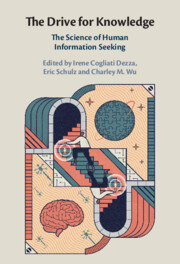Book contents
- The Drive for Knowledge
- The Drive for Knowledge
- Copyright page
- Contents
- Figures
- Tables
- Notes on Contributors
- Preface
- Part I What Drives Humans to Seek Information?
- Part II How Do Humans Search for Information?
- Part III Which Machinery Supports the Drive for Knowledge?
- Chapter 9 Information-Seeking in the Brain
- Chapter 10 Attention as Rational Choice
- Chapter 11 Seeking Inner Knowledge
- Chapter 12 Edgework
- Future Challenges
- Index
- References
Chapter 11 - Seeking Inner Knowledge
Foraging in Semantic Space
from Part III - Which Machinery Supports the Drive for Knowledge?
Published online by Cambridge University Press: 19 May 2022
- The Drive for Knowledge
- The Drive for Knowledge
- Copyright page
- Contents
- Figures
- Tables
- Notes on Contributors
- Preface
- Part I What Drives Humans to Seek Information?
- Part II How Do Humans Search for Information?
- Part III Which Machinery Supports the Drive for Knowledge?
- Chapter 9 Information-Seeking in the Brain
- Chapter 10 Attention as Rational Choice
- Chapter 11 Seeking Inner Knowledge
- Chapter 12 Edgework
- Future Challenges
- Index
- References
Summary
Information-seeking is usually conceived of as gathering information to make better decisions by observing and sampling from the external world. But for humans and many other intelligent agents, much of that information, once gathered, is also stored to guide future decisions, necessitating mechanisms for seeking information in some form of inner space. Here we survey various types of evidence suggesting that strategies adapted for search in external spatial environments are also used to seek information internally from memory. These include foraging strategies such as area-restricted search, which adaptively balances exploitation of locally clustered resources with exploration for resources more widely dispersed. We also describe how internal search satisfies the predictions of external foraging theory via the Marginal Value Theorem and show how these predictions can be used to investigate individual differences in memory search such as those caused by aging and cognitive impairment. Finally, we consider evidence that the structure of inner space may be a result of the very processes we use to search it.
- Type
- Chapter
- Information
- The Drive for KnowledgeThe Science of Human Information Seeking, pp. 237 - 258Publisher: Cambridge University PressPrint publication year: 2022
References
- 1
- Cited by

